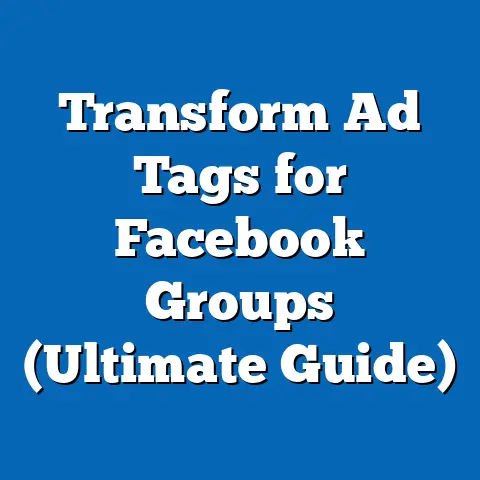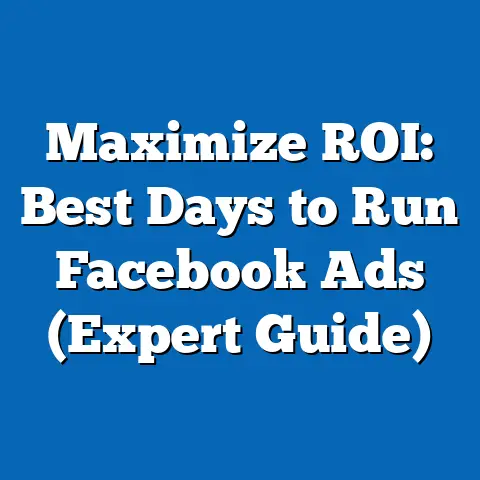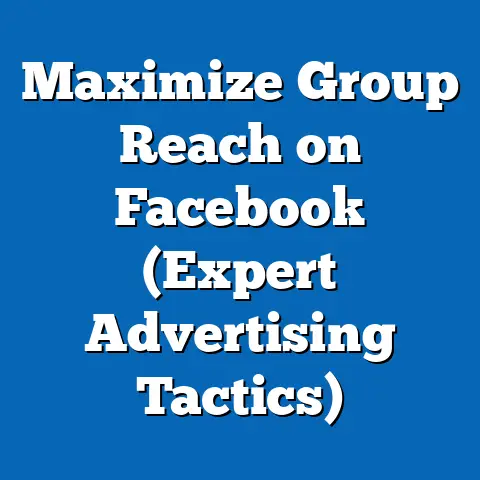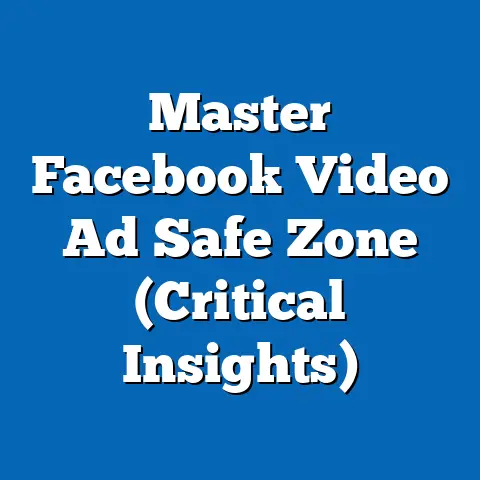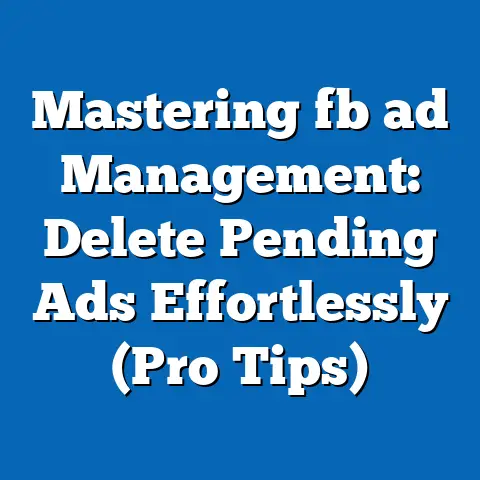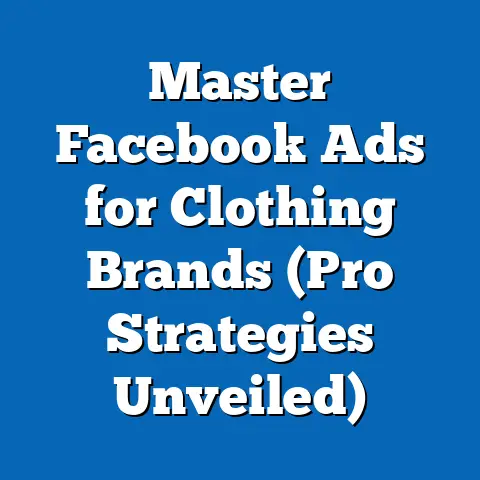Master Facebook Ad Balance (Essential Guide)
Facebook advertising has become a cornerstone of digital marketing, offering unparalleled reach with over 2.9 billion monthly active users as of 2023 (Statista, 2023). Among the myriad strategies for capturing attention in this crowded space, achieving the right “ad balance”—a harmonious blend of bold design, compelling content, and strategic targeting—stands out as essential for success. This guide delves into the critical elements of mastering Facebook ad balance, with a particular focus on bold designs as a defining characteristic, while exploring their historical context, societal implications, and practical applications.
The concept of ad balance is not merely about aesthetics; it’s about creating campaigns that resonate emotionally, drive engagement, and deliver measurable results. Bold designs play a pivotal role in this equation by cutting through the noise of users’ newsfeeds. However, balance requires more than just eye-catching visuals—it demands an understanding of audience psychology, platform algorithms, and evolving cultural trends.
Section 1: Bold Designs in Facebook Ads – Defining Characteristics
What Constitutes a Bold Design?
Bold designs in Facebook advertising are characterized by their ability to grab attention instantly amidst a sea of competing content. This often involves the use of vibrant colors, striking imagery, unconventional layouts, and typography that demands a second glance. Unlike minimalist or subtle approaches, bold designs aim to evoke strong emotional responses—whether through humor, curiosity, or awe.
A key feature of bold design is contrast, both visually and conceptually. For instance, pairing a bright neon background with stark black text or juxtaposing unexpected elements (like a surreal image with a serious message) can create a memorable impression. According to a 2022 study by HubSpot, ads with high visual contrast are 38% more likely to be noticed by users scrolling through social media feeds.
Another defining trait is authenticity. Bold designs often break away from generic templates, reflecting a brand’s unique identity or taking risks with unconventional storytelling. However, boldness without purpose can alienate audiences, making balance with relevance and clarity equally important.
The Role of Boldness in Engagement
Bold designs are not just about aesthetics—they are strategically engineered to combat “banner blindness,” a phenomenon where users subconsciously ignore ads due to overexposure. Research from Nielsen (2021) indicates that users spend an average of just 1.7 seconds viewing an ad on social media before deciding to engage or scroll past. Bold visuals act as a hook in this fleeting window, increasing the likelihood of clicks, shares, and conversions.
Yet, boldness must be tailored to the target demographic. A younger audience on Facebook, such as Gen Z, may respond well to memes or edgy graphics, while older users might find overly aggressive designs off-putting. Thus, the effectiveness of bold design lies in its alignment with audience preferences and cultural context.
Section 2: Historical Context of Bold Design in Digital Advertising
The Evolution of Facebook Ads
Facebook launched its advertising platform in 2007 with “Flyers,” a rudimentary ad format that allowed businesses to target users based on profile data. These early ads were text-heavy and visually uninspiring, often blending into the platform’s interface. It wasn’t until the introduction of News Feed ads in 2012 that visuals became a central component of Facebook advertising, paving the way for bold designs to emerge.
The shift to mobile-first browsing in the mid-2010s further accelerated the need for eye-catching creatives. With smaller screens and shorter attention spans, advertisers began experimenting with brighter colors, dynamic carousels, and video content to stand out. By 2017, Facebook reported that ads with rich media (images and videos) outperformed text-only ads by 65% in terms of engagement (Facebook Business, 2017).
Cultural and Technological Influences
The rise of bold design also mirrors broader cultural shifts. The 2010s saw the proliferation of visual-first platforms like Instagram and Snapchat, which conditioned users to expect high-impact, aesthetically pleasing content. Advertisers on Facebook adapted by adopting similar principles—think punchy graphics and influencer-style imagery—to meet evolving user expectations.
Technological advancements, such as improved ad targeting and machine learning algorithms, further enabled bold designs to thrive. Facebook’s algorithm began prioritizing content that sparked engagement, rewarding ads with strong visual appeal. This created a feedback loop where bolder, more creative designs gained traction, shaping the modern landscape of digital advertising.
Key Milestones in Bold Design Adoption
Several iconic campaigns highlight the historical significance of bold design on Facebook. Coca-Cola’s 2014 “Share a Coke” campaign, for instance, used personalized names on vibrant red cans, combining bold imagery with emotional resonance. The campaign garnered over 500,000 user-generated posts, demonstrating the power of visually striking content to drive virality.
Similarly, Spotify’s annual “Wrapped” ads, launched in 2016, use bold, data-driven visuals to engage users with personalized insights. These campaigns illustrate how boldness, when paired with relevance, can transform ads into cultural moments. Over time, such examples have set a benchmark for creativity on the platform, influencing marketers worldwide.
Section 3: Societal Implications of Bold Designs in Facebook Ads
Shaping Consumer Behavior
Bold designs do more than capture attention—they shape how consumers perceive brands and make purchasing decisions. By leveraging emotional triggers through striking visuals, advertisers can create a sense of urgency or aspiration, influencing everything from impulse buys to brand loyalty. A 2023 report by Kantar found that visually bold ads on social media increase purchase intent by 27% compared to neutral designs.
However, this power comes with responsibility. Overly aggressive or manipulative designs can erode trust, especially if they prioritize shock value over authenticity. For instance, clickbait-style ads with exaggerated imagery often lead to high bounce rates, as users feel misled after clicking through.
Cultural Impact and Representation
Bold designs also reflect and influence cultural norms. In an era of social awareness, ads that use bold visuals to challenge stereotypes or promote inclusivity can resonate deeply with audiences. Nike’s 2018 campaign featuring Colin Kaepernick, with its stark black-and-white imagery and provocative tagline (“Believe in something. Even if it means sacrificing everything.”), sparked global conversations about activism and brand values.
Conversely, bold designs that rely on outdated tropes or cultural insensitivity can backfire. The backlash against tone-deaf campaigns underscores the need for advertisers to balance boldness with cultural competence, ensuring their visuals align with societal values.
Ethical Considerations
Privacy is another concern. Bold ads often rely on hyper-targeted data to maximize impact, raising questions about user consent and data ethics. As Facebook faces ongoing scrutiny over data practices, advertisers must navigate these issues carefully to maintain public trust.
Section 4: Achieving Ad Balance – Beyond Bold Design
The Components of Ad Balance
While bold design is a critical element, achieving ad balance on Facebook requires integrating several components: compelling copy, precise targeting, strategic timing, and clear calls-to-action (CTAs). Balance means ensuring that no single element overshadows the others, creating a cohesive user experience. For example, a visually stunning ad with unclear messaging can confuse viewers, reducing its effectiveness.
Copywriting plays a pivotal role in complementing bold visuals. Short, punchy headlines that evoke curiosity or emotion can amplify a design’s impact. According to WordStream (2022), ads with emotionally charged copy see a 31% higher click-through rate (CTR) than neutral messaging.
Targeting is equally crucial. Facebook’s robust ad manager allows marketers to segment audiences by demographics, interests, and behaviors, ensuring bold designs reach the right viewers. Misaligned targeting can render even the most striking ad irrelevant, wasting budget and effort.
The Role of Data and Testing
Data-driven decision-making is the backbone of ad balance. A/B testing different design elements—such as color schemes, image styles, or CTA placements—helps identify what resonates with specific audiences. Facebook’s built-in analytics tools provide insights into metrics like CTR, cost-per-click (CPC), and conversion rates, enabling continuous optimization.
For instance, a 2021 case study by Social Media Examiner revealed that a small e-commerce brand increased its conversion rate by 42% after testing bold versus minimalist ad designs over a month. Such iterative testing ensures that boldness serves a purpose rather than becoming a gimmick.
Adapting to Algorithm Changes
Facebook’s algorithm evolves constantly, impacting how ads are displayed and prioritized. Recent updates, such as the 2021 shift toward “meaningful interactions,” have emphasized content that sparks genuine engagement over purely promotional material. Bold designs must therefore align with this focus, prioritizing value-driven messaging alongside visual appeal.
Marketers should also consider platform-specific trends, such as the growing popularity of Stories and Reels. These formats demand vertical, immersive designs that maintain boldness while adapting to shorter attention spans. Staying agile in response to such changes is key to maintaining ad balance.
Section 5: Practical Strategies for Mastering Facebook Ad Balance
Crafting Bold Yet Balanced Designs
-
Leverage Color Psychology: Use colors that evoke specific emotions tied to your brand or campaign goal. For example, red can signify urgency, while blue conveys trust. Avoid overwhelming users by balancing bold hues with neutral tones.
-
Prioritize Mobile Optimization: With 98.5% of Facebook users accessing the platform via mobile devices (Statista, 2023), designs must be legible and impactful on small screens. Test visuals for clarity and ensure text isn’t cut off in previews.
-
Incorporate Motion: Animated GIFs or short videos can enhance boldness without cluttering the ad. A 2022 study by Animoto found that video ads on Facebook generate 3x more engagement than static images.
Aligning with Audience Expectations
Understanding your audience’s generational and cultural nuances is critical. Millennials, for instance, value authenticity and may respond to bold designs that highlight social causes, while Gen Z often gravitates toward humor and interactivity. Use Facebook’s Audience Insights tool to gather demographic data and tailor your approach accordingly.
Additionally, consider the diversity within your audience. A one-size-fits-all bold design risks alienating segments of your market. Instead, create variations of your ad to resonate with different cultural or regional preferences, ensuring inclusivity.
Budgeting and Scaling
Achieving ad balance also involves financial strategy. Start with a modest budget to test bold designs and messaging, then scale up once you’ve identified high-performing elements. Facebook’s automated bidding options, like “lowest cost,” can help optimize spend while maximizing reach.
Avoid overspending on overly bold campaigns without proven results. A balanced approach to budgeting ensures you can experiment with creativity while maintaining a sustainable return on investment (ROI).
Section 6: Case Studies – Bold Design and Ad Balance in Action
Case Study 1: Airbnb’s “Live There” Campaign
In 2016, Airbnb launched its “Live There” campaign on Facebook, using bold, immersive imagery of unique travel destinations paired with the tagline, “Don’t go there. Live there.” The visuals featured high-contrast photos and videos of local experiences, standing out in users’ feeds.
The campaign balanced boldness with emotional storytelling, emphasizing connection over transactional tourism. It resulted in a 13% increase in bookings among targeted users, proving that bold design, when paired with relatable messaging, can drive tangible outcomes (Facebook Business, 2016).
Case Study 2: Dollar Shave Club’s Viral Approach
Dollar Shave Club’s 2012 Facebook ads combined bold humor with minimalist design, featuring quirky videos that broke the mold of traditional razor marketing. Their low-budget, high-impact visuals balanced absurdity with a clear value proposition (“Shave time. Shave money.”).
This approach not only garnered millions of views but also positioned the brand as a disruptor, appealing to younger demographics. The campaign’s success highlights how boldness in tone and design can create cultural resonance when executed thoughtfully.
Section 7: Future Trends and Forward-Looking Insights
The Rise of AI-Driven Design
Artificial intelligence (AI) is poised to revolutionize bold design in Facebook ads. Tools like Canva’s AI generator or Facebook’s own ad creation features can analyze user data to suggest optimal color schemes, layouts, and imagery. This technology promises to make bold designs more accessible to small businesses while enhancing personalization.
However, over-reliance on AI risks homogenization, as algorithms may favor trending styles over unique creativity. Marketers must balance AI assistance with human intuition to maintain originality and emotional depth.
Evolving User Expectations
As digital natives like Gen Z and Gen Alpha become dominant consumer groups, expectations for bold design will shift. These generations prioritize authenticity, interactivity, and social impact, meaning ads may need to incorporate user-generated content or gamification to stand out. Boldness will likely evolve from purely visual to experiential, emphasizing immersive storytelling.
At the same time, growing concerns about mental health and digital overload may push for subtler forms of boldness. Advertisers will need to navigate this tension, finding ways to capture attention without contributing to user fatigue.
Regulatory and Ethical Challenges
The future of Facebook advertising, including bold design, will be shaped by regulatory changes around data privacy and ad transparency. The European Union’s General Data Protection Regulation (GDPR) and similar laws worldwide are already forcing brands to rethink targeting strategies. Bold designs may need to rely less on hyper-personalization and more on universal appeal, posing both challenges and opportunities for creativity.
Ethical advertising will also gain prominence. As consumers demand accountability, bold campaigns that prioritize social good—such as those addressing climate change or diversity—could redefine what “standing out” means in the digital space.
Conclusion: Striking the Perfect Balance
Mastering Facebook ad balance is a dynamic, multifaceted endeavor that requires blending bold design with strategic precision. Bold visuals are a powerful tool for capturing attention, rooted in the platform’s historical shift toward visual-first content and reflective of broader societal trends. Yet, their impact depends on alignment with audience needs, cultural context, and ethical standards.
This guide has explored the defining characteristics of bold design, its evolution within Facebook’s ecosystem, and its implications for consumer behavior and culture. Through practical strategies and real-world case studies, we’ve highlighted how balance—across design, copy, targeting, and data—transforms bold ideas into successful campaigns. Looking ahead, emerging technologies like AI, shifting user expectations, and regulatory changes will continue to shape this landscape, challenging marketers to innovate responsibly.
While the future of Facebook advertising remains uncertain, one principle holds true: balance is the key to sustained impact. By embracing boldness with purpose and grounding creativity in data, marketers can craft ads that not only stand out but also build meaningful connections in an ever-evolving digital world.

